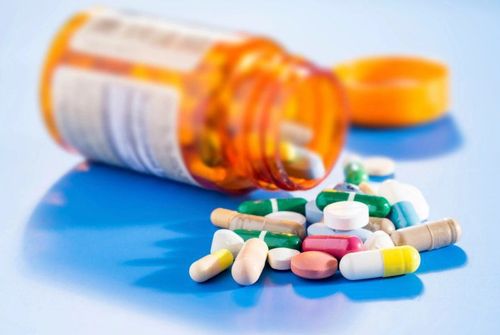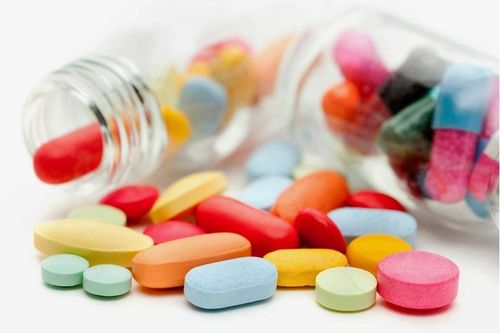This is an automatically translated article.
Medofalexin is known as the brand name of a first generation Cephalosporin antibiotic, used in the treatment of infections caused by bacteria. To avoid drug resistance, the antibiotic Medofalexin 500 will be prescribed by a doctor. However, learning about the uses and uses of drugs will help you better understand drugs and how to use antibiotics safely and effectively.
1. What is Medofalexin?
Medofalexin 500 is a prescription drug and the brand name of Cephalexin. This medicine comes in a hard capsule dosage form. Each Medofalexin 500 hard capsule contains 500mg of Cephalexin (in the form of Cephalexin monohydrate) and a number of other excipients just enough: Microcrystalline cellulose (Avicel PH 102); Magnesium stearate; Colloidal silicon dioxide. What is the cephalexin in Medofalexin?
Cephalexin is a 1st generation Cephalosporin antibiotic that works by interfering with the formation of the bacterial cell wall and breaking down the "walls" and killing the bacteria. Therefore, this medicine should only be used to treat bacterial infections, not to treat diseases caused by viruses.
2. Uses of Medofalexin 500
Cephalexin in Medofalexin 500 has the same antibacterial spectrum as other 1st generation Cephalosporins. The drug is effective against strains of Staphylococcus aureus that are resistant to Penicillin or Ampicillin. Staphylococcus aureus is a very common pathogen of the skin, sometimes also in the lungs, endocardium, or bone marrow. Cefalexin is also active against most ampicillin-resistant Escherichia coli. This is a bacterium that normally lives in the intestines of humans and animals. Some strains of bacteria are resistant to cefalexin, such as most Enterococcus strains (Streptococcus faecalis) and a few strains of Staphylococcus. In addition, Cefalexin also has in vitro activity against some other strains of bacteria.
Therefore, Medofalexin 500 is used to treat the following infections caused by susceptible bacteria:
Respiratory tract infections such as bronchitis, pneumococcal pneumonia,... Ear, nose and throat infections such as: pharyngitis and tonsillitis, otitis media, mastoiditis, sinusitis,... Tooth infections Skin and soft tissue infections Bone and joint infections Genitourinary infections. Gonorrhea (when penicillin is not suitable) Prophylaxis of infective endocarditis in people allergic to penicillin However, if the infection is severe, Medofalexin 500 is not usually indicated.
3. Use Medofalexin 500 safely and effectively
3.1 Some subjects to note before prescribing Medofalexin Do not use the drug if you:
Allergic to the drug, to other Cephalosporin antibiotics or any of the ingredients of Medofalexin 500. History of penicillin-induced anaphylaxis or other severe IgE immune globulin-mediated reaction. Medofalexin should be used with caution in the following subjects:
Pregnant or lactating women: the drug is not expected to harm an unborn baby, but may pass into breast milk. Tell your doctor to be considered in the use of the drug Operator of machinery, working at height, driving or in some other cases where the side effects of headache, dizziness, fatigue of the drug may affect dangerous work for drug users. In patients with renal impairment, because the drug is eliminated by the kidneys, it may be necessary to reduce the dose accordingly. People who are allergic to penicillin, but there are also a few that cause cross-allergies. You should also tell your doctor if you have an intestinal condition such as colitis or liver problems. 3.2 Dosage of Medofalexin and some notes when using Medofalexin 500 dose varies depending on age and some specific conditions and treatment response of each patient:
For adults, the dose is from 1 to 2 times a day. 500mg to 1000mg, at least 6 hours between doses. For children over 2 years old, use 25-60mg of the drug for every kg of body weight in 24 hours, evenly dividing the amount into 2 to 3 oral doses. In some severe cases, the dose can be increased to 100mg/kg body weight. It is recommended to use the drug for the full course prescribed by the doctor, usually from 7 to 10 days. With recurrent, chronic, persistent, or complicated UTIs, the course of treatment can be up to 14 days with a dose of 2 Medofalexin 500 tablets twice a day. In the treatment of gonorrhea, Medofalexin usually only needs to be used as a single dose of 6 tablets with 1 g probenecid if the user is male and 4 tablets with 0.5 g probenecid for female. Take this medication with plenty of water to avoid choking. Can be taken with or without food. You need to take Medofalexin 500 for the prescribed course, even if the symptoms disappear after a few days. Stopping the medication too soon may cause the infection to return or get worse.
Tell your doctor if symptoms persist or get worse. Do not share this medicine with others or take it for a future infection.
If overdosing on Medofalexin usually causes only symptoms such as nausea, vomiting and diarrhea, but in some cases, it can cause neuromuscular hypersensitivity, seizures, especially in patients. kidney failure. Immediately call an ambulance or rush the patient to the nearest medical facility.
3.3 Medofalexin 500 Interactions Tell your doctor about all your other medicines, especially:
Metformin ; Probenecid. Medofalexin 500 may affect some tests such as Coombs test, urine glucose test, ... erroneous test results. Make sure all your doctors know you are using this medicine.
4. Side effects of Medofalexin 500
If there are signs of an allergic reaction such as hives, difficulty breathing, itching, swelling of the throat, neck, face, etc. or a serious skin reaction such as a red/purple skin rash with blistering and peeling, skin pain, burning eyes, fever, sore throat, call 911 immediately for help.
There are also some serious side effects of the drug that you need to tell your doctor right away, such as:
Severe stomach pain, watery or bloody diarrhea (even if it happens to you). out several months after your last dose); Unusual tiredness, lightheadedness, or trouble breathing; Easy bruising or unusual bleeding; Seizures ; Pale skin, cold limbs; Jaundice, dark urine; Fever with weakness Pain in the side or lower back, painful urination. Common side effects of Medofalexin 500 may include: Diarrhea; Nausea, vomiting; Indigestion, stomach pain; Vaginal itching/discharge. This article does not cover the full drug interactions and side effects of Medofalexin. If you have any questions or have symptoms of other side effects, seek medical advice.
Follow Vinmec International General Hospital website to get more health, nutrition and beauty information to protect the health of yourself and your loved ones in your family.
Please dial HOTLINE for more information or register for an appointment HERE. Download MyVinmec app to make appointments faster and to manage your bookings easily.













